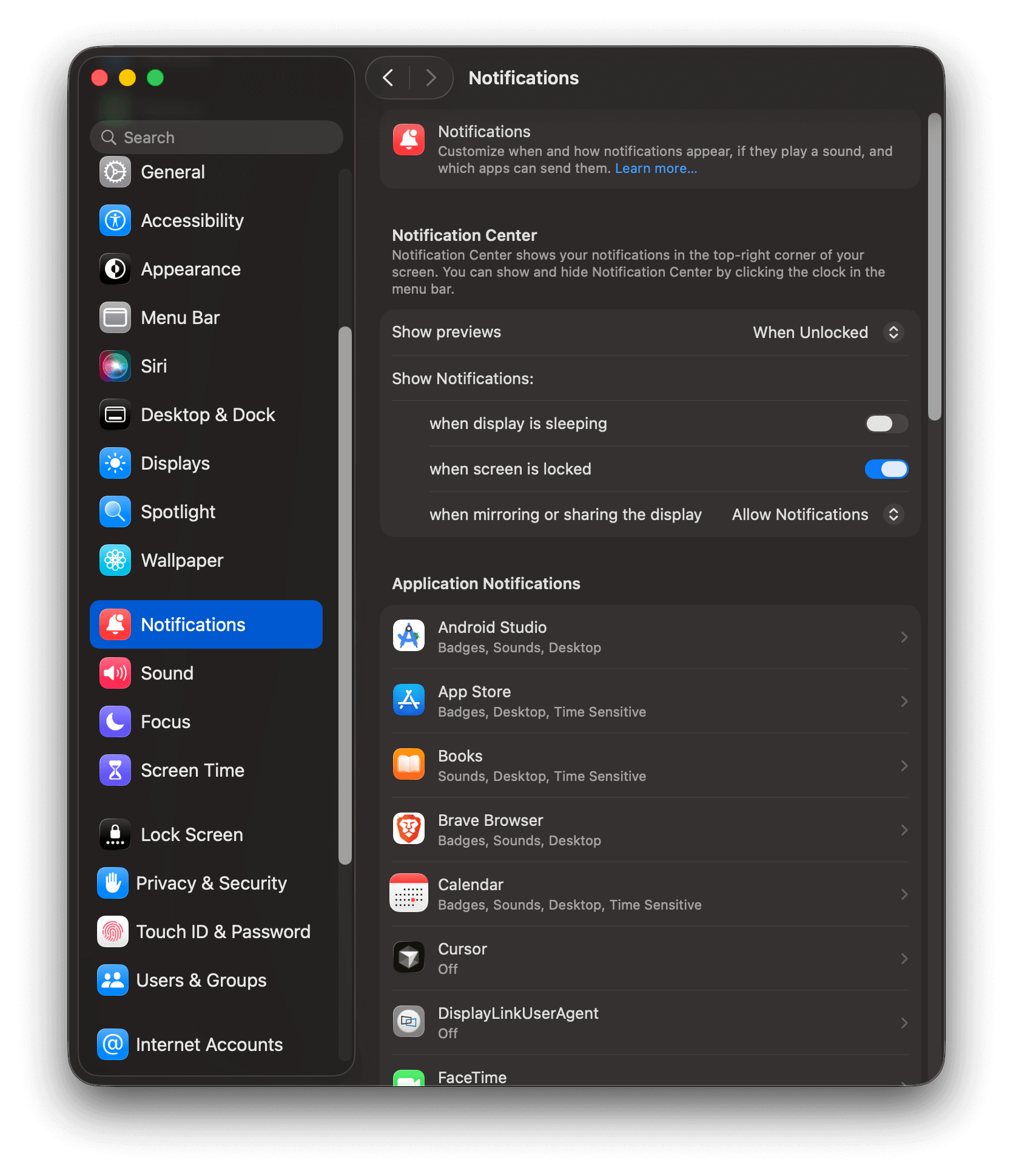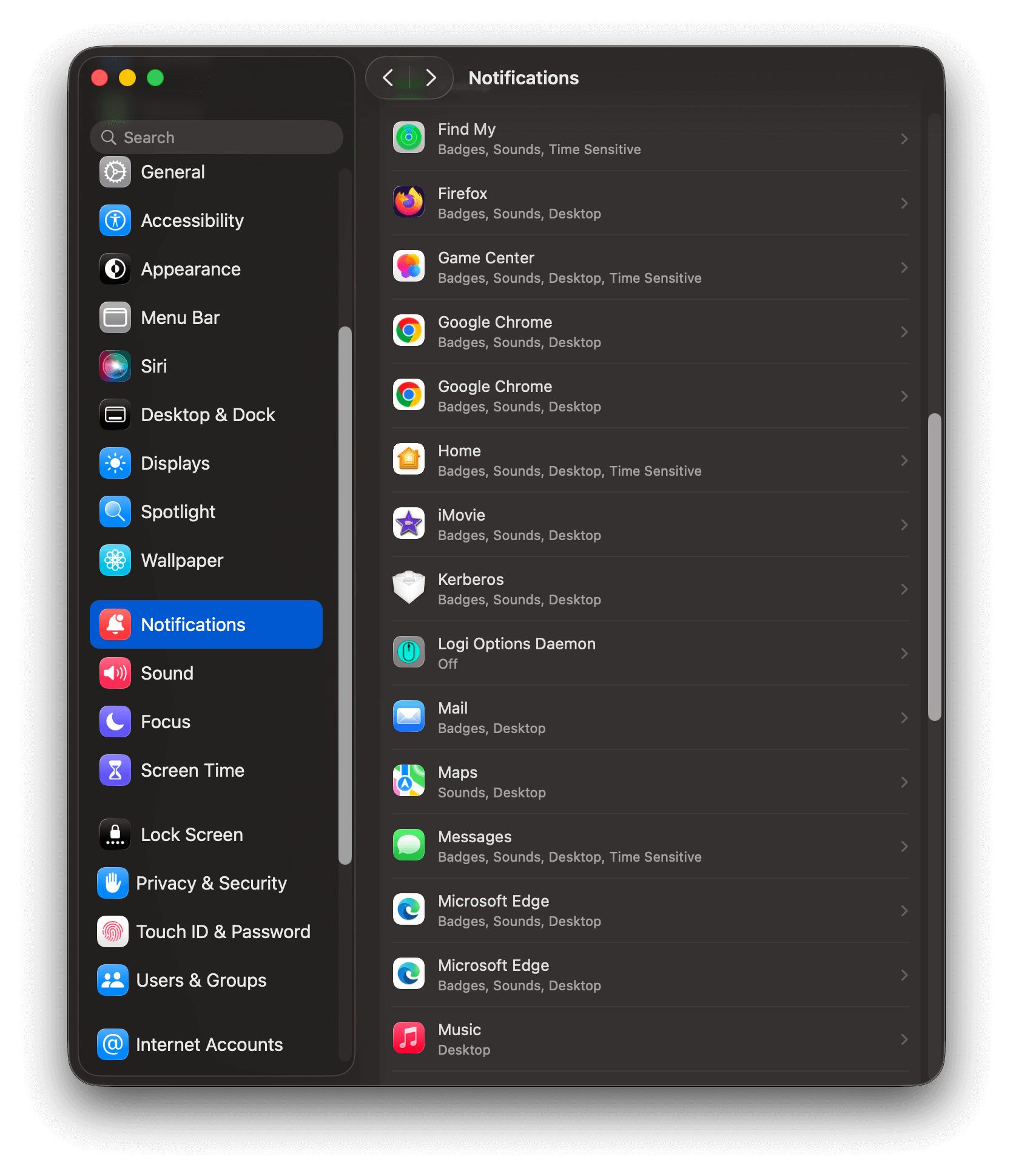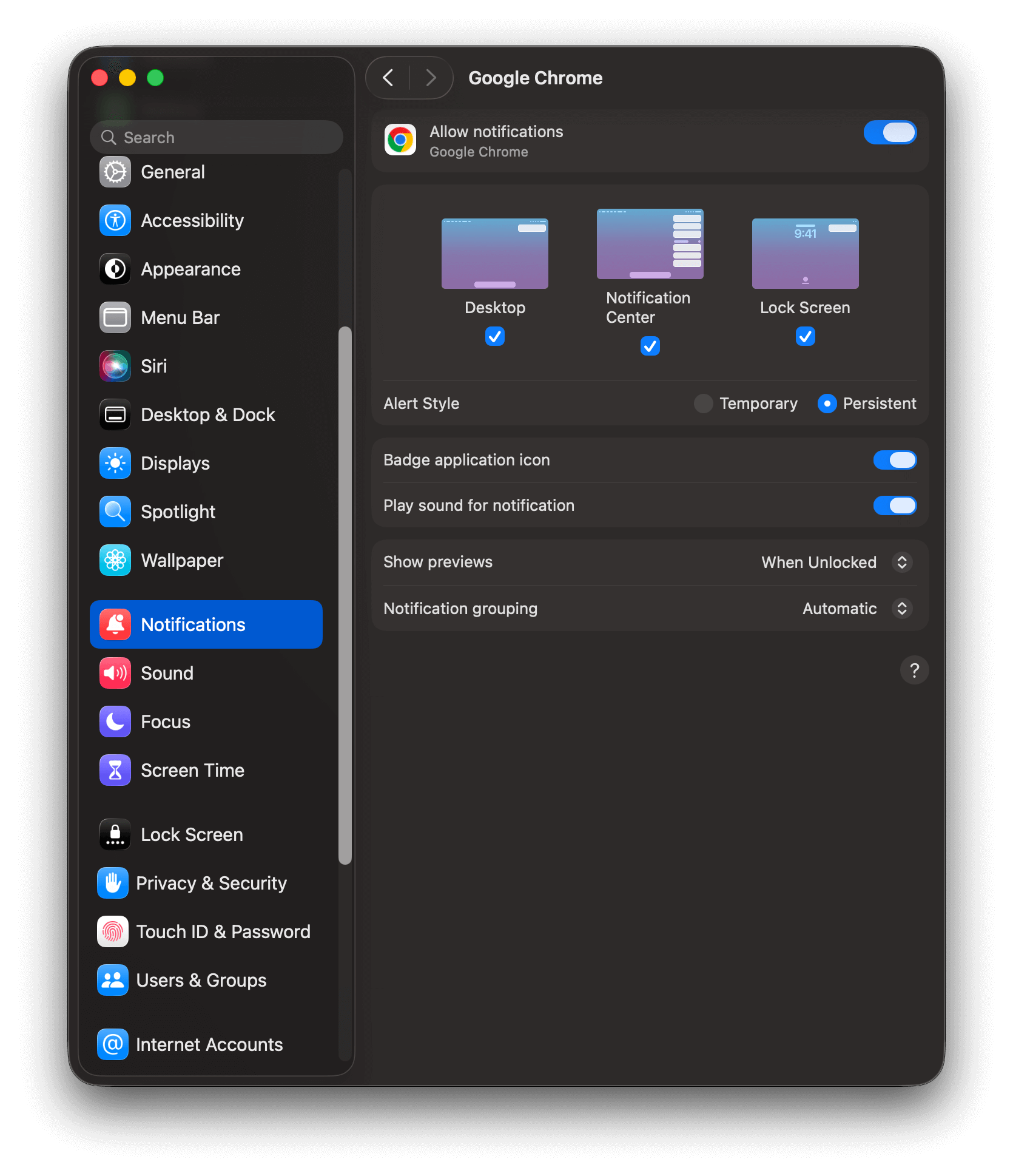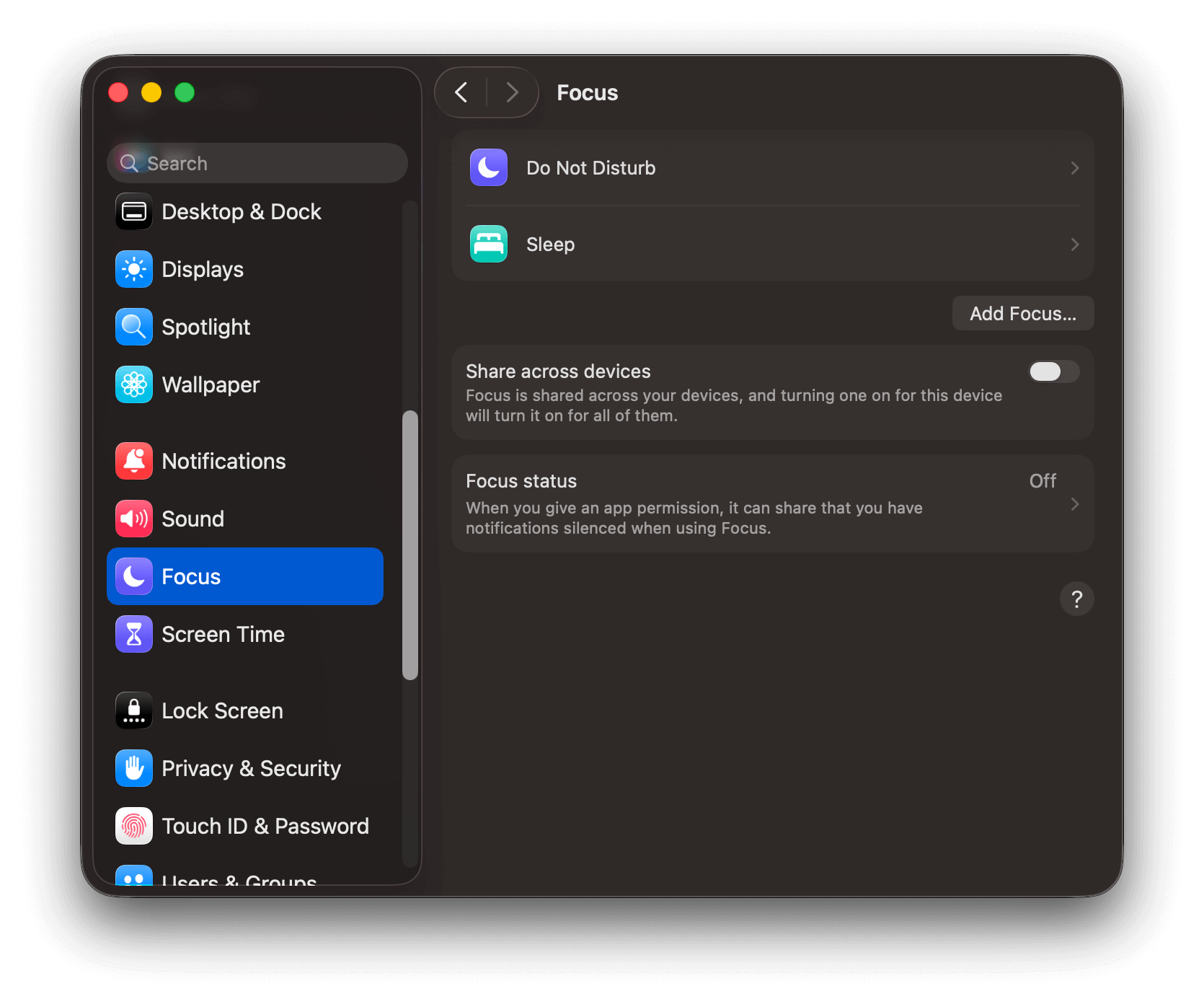Overview
This guide walks you through troubleshooting your OneSignal Web SDK setup. Before continuing, review the Web SDK Setup to ensure you’ve completed all steps. The most common reasons web push appears to not be working are actually related to your browser and device’s notification settings:Browser compatibility
Users may see web permission prompts but cannot subscribe to push notifications in incognito, private, or guest browser modes.Browser compatibility by operating system
Browser compatibility by operating system
| Browser | Windows | macOS | Android | iOS |
|---|---|---|---|---|
| Chrome | ✅ | ✅ | ✅ | ✅ ¹ |
| Firefox | ✅ | ✅ | ✅ | ✅ ¹ |
| Safari 10+ | ❌ | ✅ | ❌ | ✅ ¹ |
| Microsoft Edge | ✅ | ✅ | ✅ | ✅ ¹ |
| Opera ² | ✅ | ✅ | ✅ | ✅ ¹ |
| Samsung Internet ² | ❌ | ❌ | ✅ | ✅ ¹ |
| Yandex ² | ✅ | ✅ | ✅ | ✅ ¹ |
| UC Browser ² | ✅ | ❌ | ✅ | ✅ ¹ |
| Internet Explorer | ❌ | ❌ | ❌ | ❌ |
| DuckDuckGo | ❌ | ❌ | ❌ | ❌ |
Device notification settings
Your device’s Notification Settings and Focus modes (Do Not Disturb, Low battery, etc.) may be blocking notifications from appearing. You may also have notifications turned off for specific apps like your browsers. Check the following to make sure your device is configured to receive notifications.- Windows
- macOS
- Android
- iOS
Windows 10 Notification Settings
Windows 10 Notification Settings
- Select Start > Settings > Notifications & Actions > Get notifications from apps and other senders
- Make sure your site and browser are also enabled.
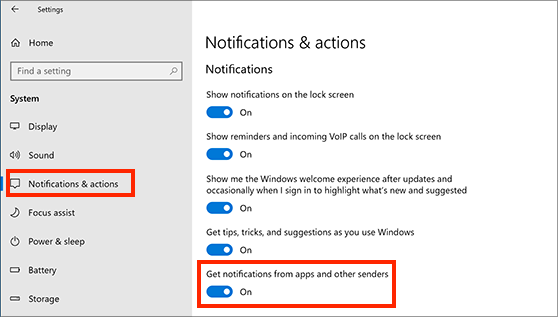
Windows 10 Notification Settings
- Select Start > Settings > System > Notifications
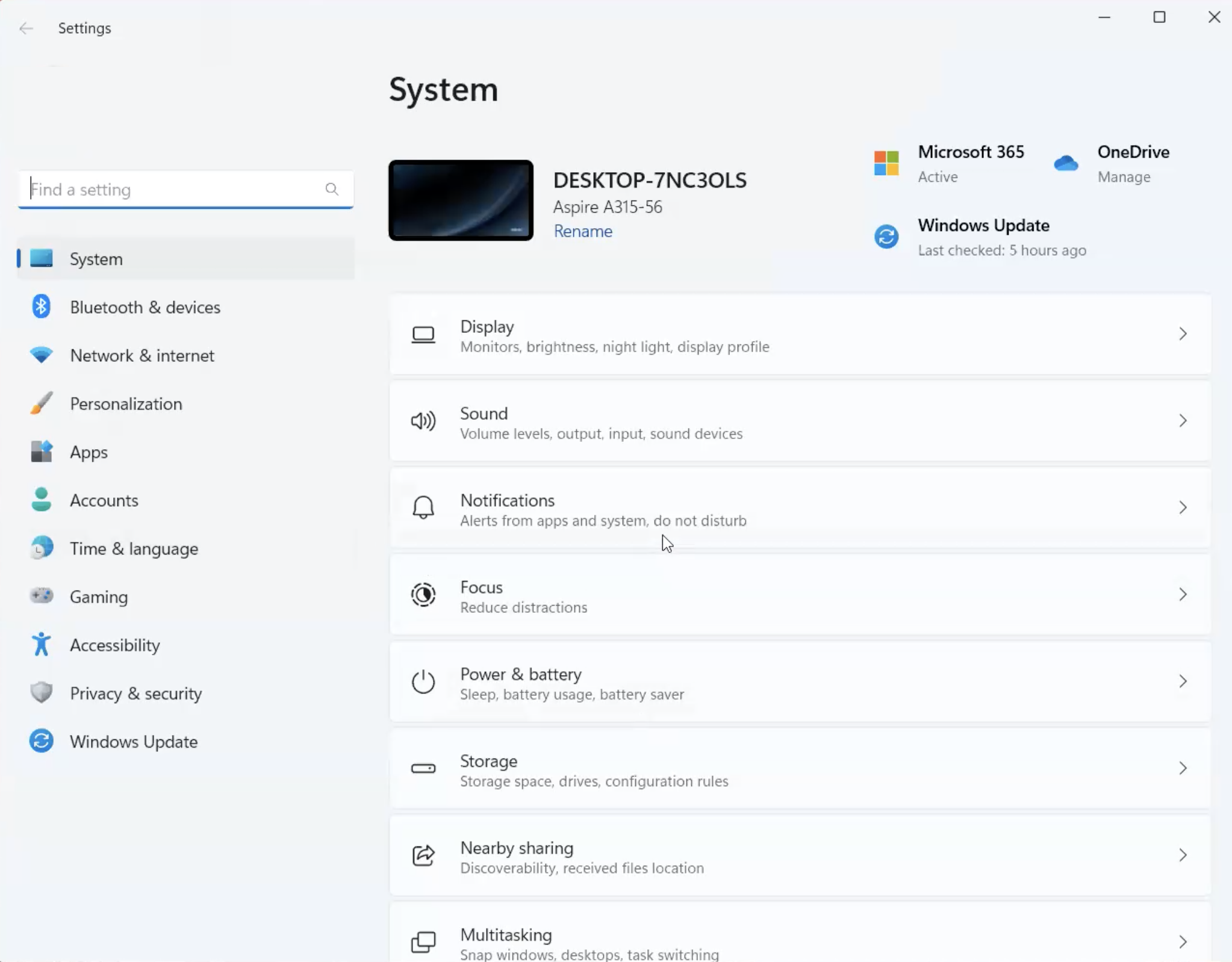
Windows 11 Notification Settings
- Turn On Notifications
- Turn Off Do not disturb (while testing, push will show when this is disabled)
- Scroll down under Notifications from apps and other senders
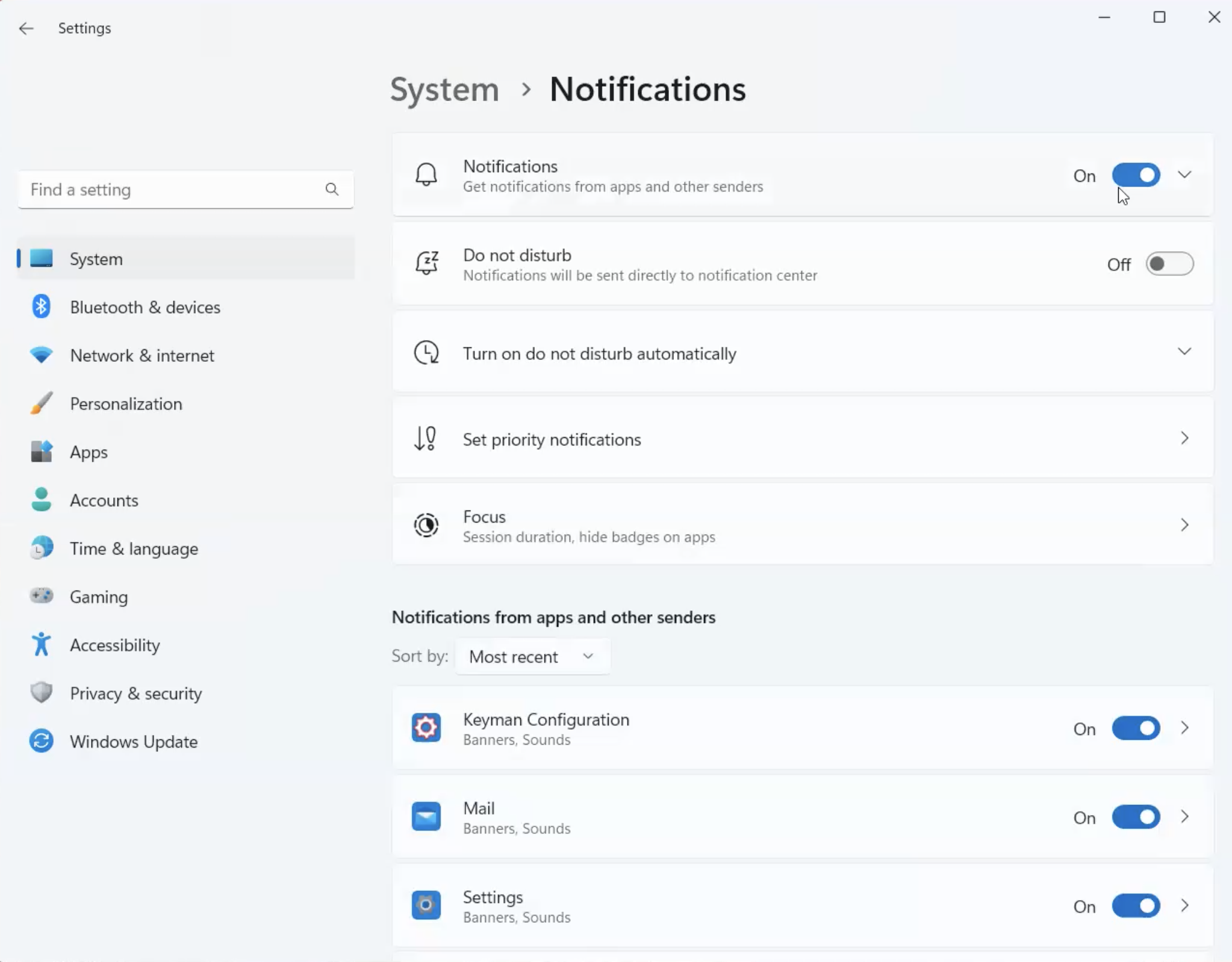
- Make sure your browsers are turned On.
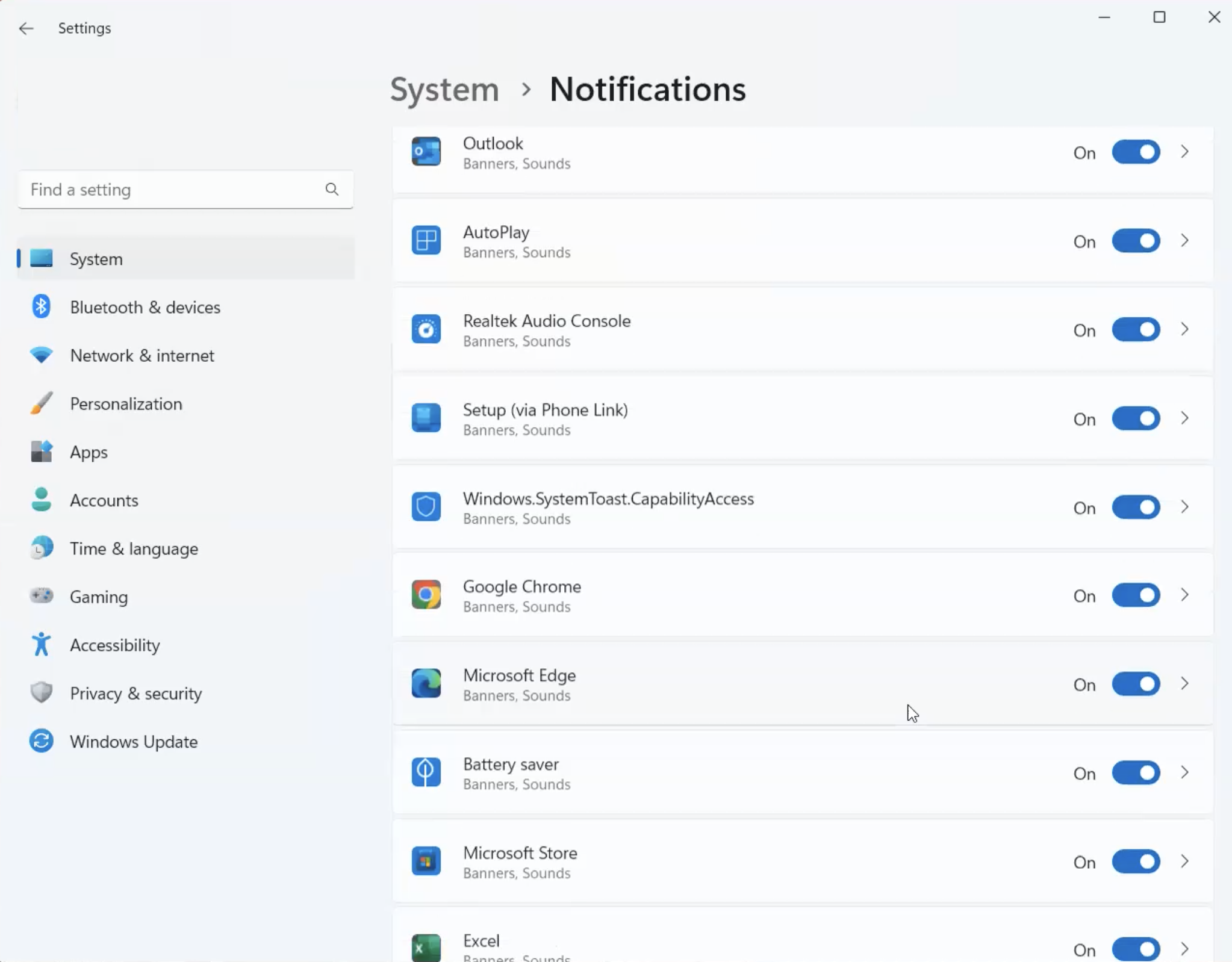
Windows 11 Notification Settings Browser List
Prompt display issues
The following are common reasons why the web push notification prompt may not display as expected.Confirm a prompt is configured
Check browser compatability, incognito, private browser, or guest browser modes.
Check your browser's Notification Settings
chrome://settings/content/notifications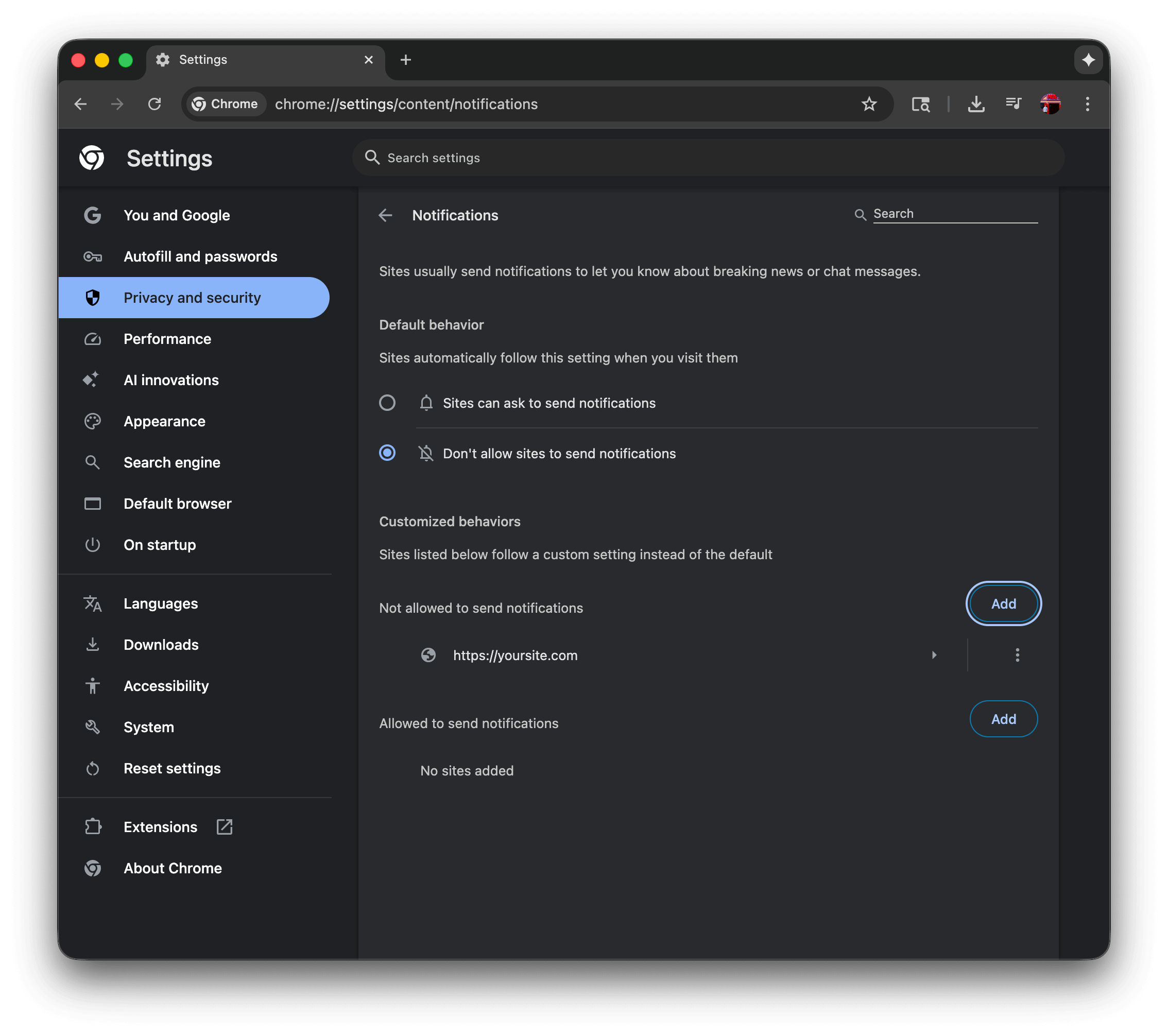
Chrome Notifications settings
- The user has selected “Don’t allow sites to send notifications” which will prevent the native permission prompt from showing. This must show “Sites can ask to send notifications” to allow the native permission prompt to show.
- The user has added
https://yoursite.comto the “Not allowed to send notifications” list, which will prevent the native permission prompt from showing. This must be removed from the list to allow the native permission prompt to show.
- Chrome - This page explains how to manage notifications in Chrome by going to Settings > Privacy and security > Site Settings > Notifications, where you can control default behavior and manage permissions for individual websites.
- Firefox - This guide covers Firefox’s Web Push notifications, explaining how to manage notification permissions through Settings > Privacy & Security > Notifications, and how to control permissions for specific sites through the address bar’s site information icon.
- Safari - This Apple guide explains how to customize Safari notifications on Mac through Safari > Preferences > Websites > Notifications, where you can manage which sites can send notifications and control notification behavior through System Preferences.
- Edge - This article details how to manage Edge notifications by navigating to Settings > Privacy, search, and services > Site permissions > Notifications, or by clicking the site information icon in the address bar.
iOS/iPadOS requirements are not met.
Troubleshooting steps
After checking the above, follow these steps to troubleshoot your OneSignal Web SDK setup.Open the browser developer tools console
- Desktop
- Android
- iOS
- Chrome: Right click on the page, click Inspect, and click the Console tab of the popup window that opens up.
- Firefox: Right click on the page, click Inspect element, and click the Console tab of the popup window that opens up.
- Safari: Go to Safari → Preferences → Advanced and make sure Show Develop menu in menu bar is checked. Then, on your webpage, right click, click Inspect element, and click the Console tab of the popup window that opens up.
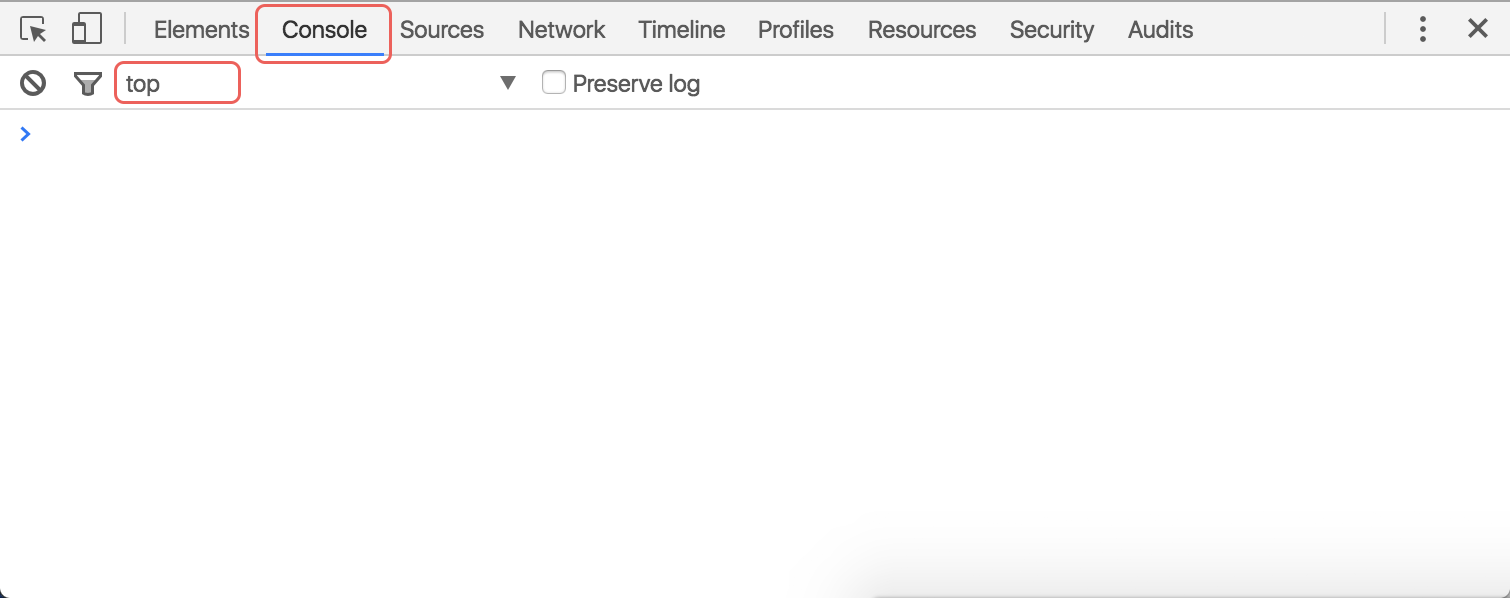
Desktop Developer Tools Console
Verify OneSignal has loaded and initialized on your page.
true✅ - OneSignal is initialized and ready. Continue to the next step.false⚠️ - OneSignal loaded but hasn’t finished initializing yet. Wait a moment and try again.Uncaught ReferenceError: OneSignal is not defined❌ .Verify the OneSignal JavaScript snippet is in your site’s<head>section, Check that the script loads before you try to use OneSignal methods.Review the Web SDK Setup guideOneSignal is already definedThe SDK is being initialized more than once on the same page. Remove one initialization method. If using the WordPress plugin, remove any manual OneSignal code from your theme files.
Enable web SDK logging
- You should see
undefinedas the result. - Close the tab and open a new one to the same page. Refreshing alone won’t trigger all SDK initialization events.
- You will start to see OneSignal SDK logs in the Console.
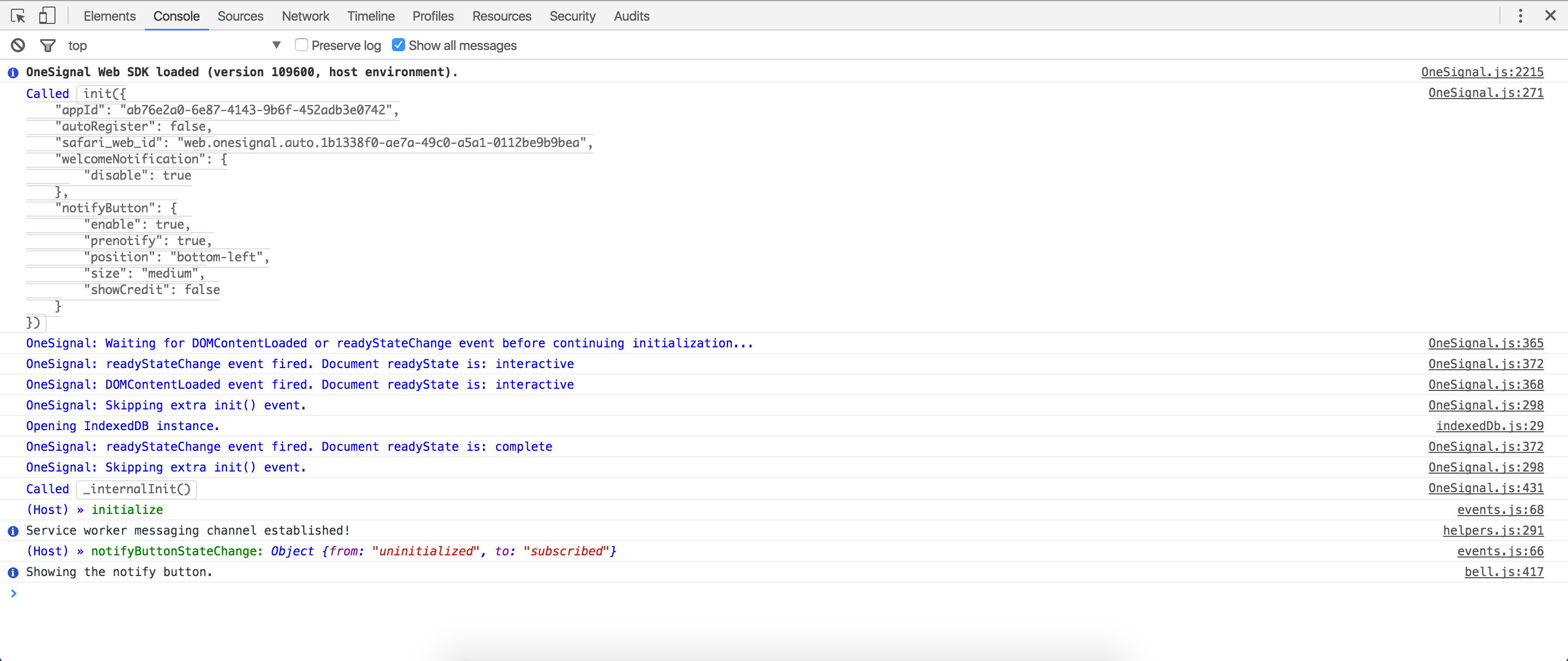
Console with verbose SDK logs
Configuration errors
You may encounter the following errors after OneSignal initializes:
Duplicate SDK initialization error
init code is being called more than once, often caused by combining WordPress plugin setup with manual code or accidentally adding the OneSignal init code multiple times.
How to fix: Remove any duplicate init calls. If using the WordPress plugin, remove any manual OneSignal code from your theme files.

Example shows the URL set in OneSignal dashboard `http://127.0.0.1:5501` is not the current site origin you are visiting.
- Protocol: Must be
https://(for local testing, see Localhost configuration) - Domain:
example.comvswww.example.com - Subdomain:
app.example.comvsexample.com

Example of the HTTP site not supported error
https://your-label.os.tc and not your actual site origin. This is because web push isn’t supported on HTTP sites or websites that cannot host service workers.
How to fix: You have 2 options, but both require your users to resubscribe because they are actually subscribed to the os.tcsubdomain.
- Create a new OneSignal App and set the new App ID in your OneSignal init code. The benefit of this is you can continue sending push from the old/original OneSignal App. Send as many notifications as you want letting your users know the site has been updated and they should come back and subscribe again to keep getting updates. Offering a discount or incentive to resubscribe goes a long way. Set the “Launch URL” to a landing page and provide them a button to easily resubscribe like our Bell prompt, Custom Link prompt, or Category Slide prompt. See Permission prompts for more details.
-
If you want to keep the same App ID, you would need to use our Update an App API to update the
chrome_web_originandsafari_site_originto your HTTPS site origin. Because these users subscribed to theos.tcsubdomain, they do not have push permissions allowed in the browser for your site. The browser doesn’t “know” they are subscribed to your site, so they will get prompted again. If they subscribe again, they will have 2 web push Subscriptions to your site on the same browser and will get duplicate notifications. For this reason, we recommend deleting all your current web push subscribers to prevent them from getting duplicate notifications. Before deleting, send a few notifications letting them know the site has been updated and they should subscribe again to keep getting updates. Offering a discount or incentive to resubscribe works really well. Set the “Launch URL” to a landing page and provide them a button to easily resubscribe like our Bell prompt, Custom Link prompt, or Category Slide prompt. See Permission prompts for more details.
Service worker installation errors
If you are presented with the Native permission prompt and click “Allow”, you may encounter the following service worker installation errors:https://your-site.com/’) with script (‘https://your-site.com/...’): A bad HTTP response code (404) was received when fetching the script.https://www.yoursite.com/’) with script (‘https://www.yoursite.com/...’): A bad HTTP response code (403) was received when fetching the script.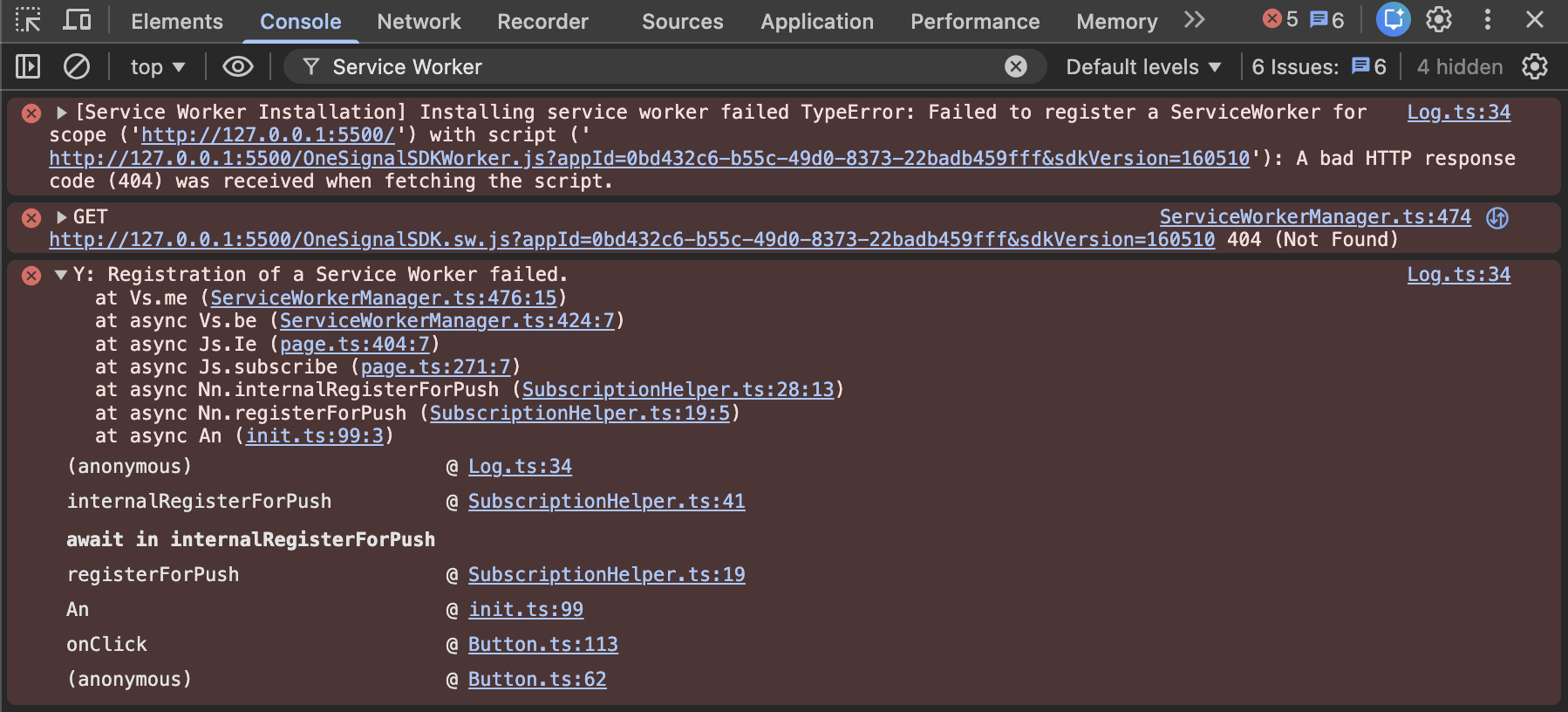
Example of a service worker installation error

MIME type error in service worker

Redirect error in console
Find your service worker path
OneSignalSDKWorker.js service worker file in the root directory of your site unless you specify a custom filename or location as described in the Service Worker Setup Guide.Make sure you have configured the correct filename, location, and scope for our SDK to find the service worker file.Visit the service worker file directly in your browser
- If you did not configure a custom location, then you should see the JavaScript code for the service worker file in your site’s root:
https://yoursite.com/OneSignalSDKWorker.js - If using WordPress, you should see it here:
https://yoursite.com/wp-content/plugins/onesignal-free-web-push-notifications/sdk_files/OneSignalSDKWorker.js - If using a custom location, you should see it here:
https://yoursite.com/your-custom-location/OneSignalSDKWorker.js
Verify the file loads
- You should see the following JavaScript code:
JavaScript
- This file must be served with a
content-typeofapplication/javascript. - There can be no redirects to this file. Files must be hosted on the same domain as your site (no CDN or proxy domains)
Notifications not shown
This section assumes:- You have reviewed the Notifications Not Shown: Web Push guide for common reasons why notifications may not be showing up in your device.
- You were shown the Native permission prompt and clicked “Allow”. See Prompt Display Issues above if you did not subscribe via the Native permission prompt.
Get your Subscription ID
- The URL of the page you are on if there is any confusion.
-
If the current browser you are using supports push notifications.
truemeans the browser supports push notifications.falsemeans the browser does not support push notifications.
-
If you are subscribed to notifications in the browser.
truemeans you allowed push permissions for this URL.falsemeans you did not allow or denied push permissions for this URL.
-
If you are opted-in with OneSignal.
truemeans your Subscription is subscribed to push notifications in OneSignal.falsemeans your Subscription is not subscribed to push notifications in OneSignal. Check for theoptOut()method is being called on your site.
-
Your OneSignal Subscription ID.
- Save this for the next step. This is the ID you will use to send yourself a push notification.
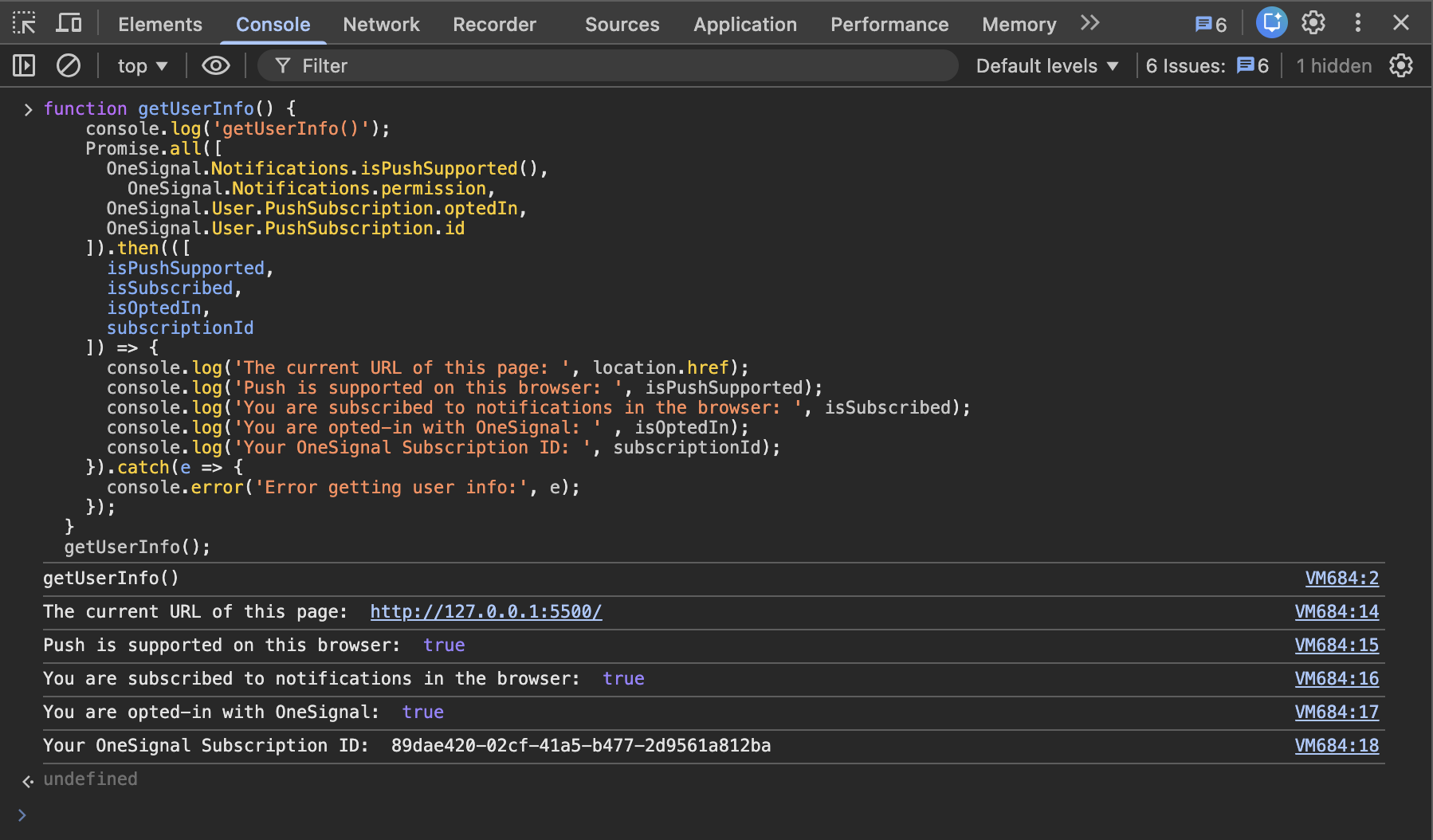
Example of user info
Send yourself a notification
Test with Chrome
- In a new tab, open
chrome://gcm-internals. - Click the “Start Recording” button on the top left. Making sure you see “Connection State: CONNECTED”.
- Leave this open and send yourself another push notification to your Chrome web push Subscription.
- You should see something in the “Receive Message Log” if you got it.
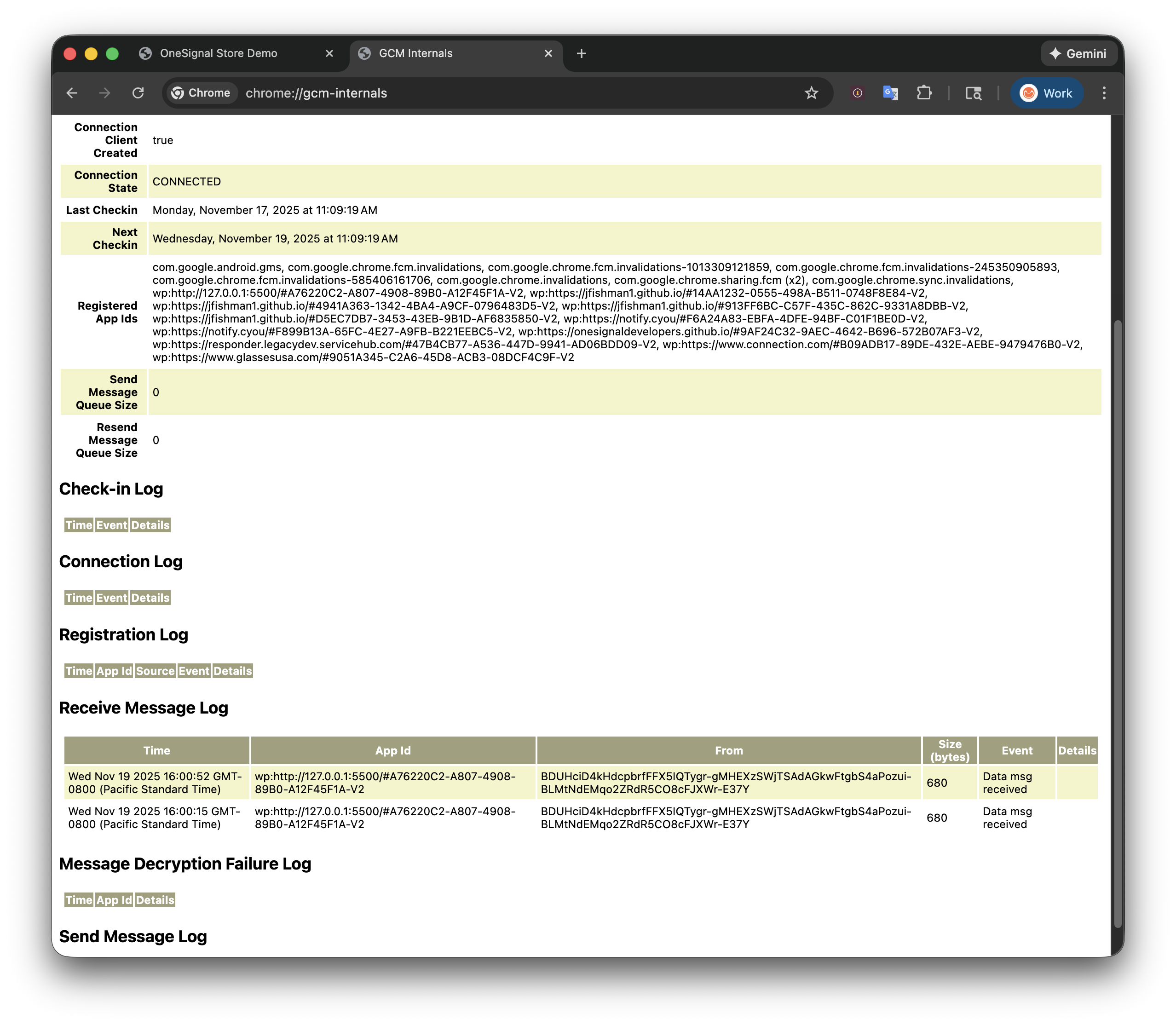
GCM internals logging
- If you don’t see a “Data msg received”, then your Chrome browser is not receiving the notification at all. Please let us know on support about this.
- If you see “Data msg received” but you still didn’t receive a notification, continue to the next step.
- Open a new tab to
chrome://serviceworker-internals - Search for
Scope: https://your-site.com(replaceyour-site.comwith your actual site domain). - Click Inspect, or Start -> Inspect. A Chrome Developer Tools popup will appear.

Inspecting the service worker
- On the Chrome Developer Tools popup to our service worker, click the Console tab, and run
OneSignalWorker.log.trace();. It should returnundefined. Any messages from our service worker should now appear in this popup.
[email protected]Please include:- Details of the issue you’re experiencing and steps to reproduce if available
- Your OneSignal App ID
- The External ID or Subscription ID if applicable
- The URL to the message you tested in the OneSignal Dashboard if applicable
- Any relevant logs or error messages
